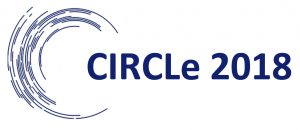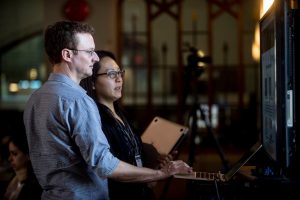Capturing and Reflecting the Learning Process through ePortfolios, 11:00 am to 12: 15 pm
To see all table discussion notes for this session, click here
Questions framing the presentations in Session 1:
- How can learning can be processed and represented using e-portfolios and online platforms?
- What do online platforms capture that other forms might not? What is problematic about using digital spaces for reflective practices?
- How can students use e-portfolios in more critical and reflexive ways?
- How should educators pedagogically distinguish between using e-portfolios as a tool for personal versus professional identity development?
- What are some best practices for documenting difficult, authentic, and complex learning experiences?
TABLE 1 DISCUSSION:
New questions raised in the group included:
- How do you balance student ePortfolio making to reflect on class + beyond amidst the stress and business in their lives?
- How do you grade or assess ePortfolios?
- Some things should be in a general outline but give room for movement
- Allow for students to workshop ePortfolios together and to receive feedback overtime. Build engagement within the student ePortfolio community.
- How to make ePortfolios work for archivists and librarians
- Mechanisms in ePortfolios to engage with practitioner presentations and readings
The following question was raised by an instructor teaching a professional development course in a Master’s program in Forestry:
- In a setting where students are very busy and overworked, how do we balance creating a portfolio that will be useful for them later with what they need to do to show what they’re learning in the Master’s program?
- Start by asking them to make an archive of their work and then select what they want to showcase that could speak to multiple audiences, perhaps
- Crucial role of audience: Students need to reflect on what audience(s) they are focusing on and selecting things specifically for that
- Allow them flexibility in what they want to show and how, what kind of format (formal portfolio, blog, something else)
- Consider removing assignment(s) from a course to make space for this in a course because it can be a great deal of work
- How do we grade them for this kind of work?
- Set out in a rubric what needs to be in there somewhere and let them choose how to show it exactly
- Consider some kind of peer workshopping/feedback and peer marking
Suggestion: Start small—ask students at first just to do small reflective assignments on a site. And then later, in another course or the same course, build up the site in small steps. Build room to grow over time and outside of that course. Allow for reflection as an integrative thing to all courses.
Networking ePortfolios: Integrating Technology with Learning and Connecting to the Real World, 1:30 pm to 2:45 pm
To see all table discussions for this session, click here
Questions framing the presentations in Session 2:
- How can educators encourage students to make connections between their academic work and life experiences?
- How might we better integrate e-portfolios in courses to improve student engagement?
- What kinds of projects get students to use the technology effectively, both during and after the course?
- What are the shared overlaps and differences between learning portfolios and career portfolios?
TABLE 1 DISCUSSION:
- Role of reflection: How much reflection is necessary?
Being able to reflect and showcase, that is important part of learning experience b/c can then understand what you took out of an experience, what you learned.- But does it go too far sometimes? How much reflection is necessary?
- Showcase your reflection so you know what skills you got from the course – recognize the problem, impact, and what to do next. Don’t want to spend too much time talking about what you did wrong; provide reflection as needed to provide context for talking about impact of what you did—focus also on the end result not just the process.
- Can go too far in cathartic aspects of reflection.
- Give guidelines to students so they do the necessary reflection but don’t get lost in the inquiry process.
- Build an inventory of reflection questions for students based on their disciplines and scaffold their reflection and ePortfolio process over their years at UBC
- Including something that went wrong is fine but focus also on what you learned from that, what are your plans for the future based on that. Showcase ability to problem solve.
- Don’t just show your shiny successes—that could just be your social media sites
- Show that you take risks sometimes and that it may not work out but you can learn from that.
- Scaffolding is important
- Start with small assignments & reflections, then include questions that help students think about deeper analysis of their learning, connections to other parts of their academic and non-academic lives, and coordinating the different parts of the portfolio together…all in small steps.
- Maybe don’t even call it a portfolio in first and second years because this can get them sidetracked
- But does it go too far sometimes? How much reflection is necessary?
- This is an online academic identity; before this they may just have social online identity
- Though the learning that can be showcased in the portfolio isn’t just academic; it’s useful to consider learning that happens outside of the university too, and how that links to academic learning
- Sharing culture: “If it wasn’t shared, it didn’t happen”—trying to encourage a culture of sharing at an organization/business. Talk about that rather than putting things into an official portfolio. There must also be some reward to the sharing.
- If people have to do their work and then also the portfolio on top of that w/o some kind of reward, that will feel too onerous.
- How might we create an incentive for faculty, staff and students to engage with sharing through eportfolios?
- Show people the benefits that are accruing from their portfolios and then others will want to do that too. E.g., like social media, who is getting “likes” on their portfolios?
- Portfolios as a 2-in-1 package: integrate Co-op with eportfolios so that eportfolios isn’t just another add-on.
- Multiple life paths: Don’t think you have to just focus on one life path, that everything has to be focused on that one dream job. There will be jobs you’re not even aware of that require multiple kinds of skills. Or you may change tracks over time. So it’s okay to include multiple types of things in your portfolio, multiple things you can do.
- Well roundedness gives you back-ups in your life and ePortfolios can be used to track your life trajectory and prove your community connections
- This could help convince students to engage with portfolios.
- Value of peer feedback on portfolios: students no longer just speaking to a wall or to the instructor, but it changes the audience and students can get more engaged that way.
Learning through Assessment and the Future of ePortfolios, 3:15 pm to 4:30 pm
To see all table discussion for this session, click here.
Questions framing the presentations in Session 3:
- What might institutional learning cultures (academic, universities, colleges) learn from e-portfolio cultures (professional careers, visual arts, performing arts) regarding approaches to assessment?
- What are best practices for creating ‘folio cultures’ for the future of education?
- What are the incentives, benefits and challenges for faculty, students and programs to use e-portfolios or personal web spaces?
- What can we do to get more value from these digital tools?
TABLE 1 DISCUSSION:
- Assessment:
- Assessment for eportfolio contest: Reflection on the artifact itself, design elements (depending on the course; could fit with a visual arts course)
- Would students w/o design background be disadvantaged? But our society is becoming increasingly visual so this is a skill that maybe students should develop.
- If there is a template that is flexible enough then students don’t have to have really strong design skills but can still make it look good.
- Discussing value of settings that allow students to choose what gets shown publicly and what doesn’t. Useful to have ability to show some things just to instructors.
- Be mindful and stay wary of the privacy of students and how they choose to represent themselves online
- ePortfolios can help students to draw links between things they do in the classroom and outside of the university, showing how their skills and expertise and interests cross these various contexts
- A platform itself can guide students towards making such connections—e.g., the new Arts portfolio platform encourages students to focus on skills and then link up to various courses and activities outside of university
- We talk a lot about reflection; what exactly does that mean in an eportfolio context?
- Why you’ve done what you’ve done, assessing it, thinking about how you can improve—metacognition on learning to see what you’ve learned and how, and what more you would like to learn
- Integration of work in a course with other courses and activities outside the university—how my skills have developed through these different activities
- Why did I do this, what inspired me, what motivated me to do this particular project?
- What challenges did I run into and how did I address them? You can’t share this sort of thing in your final project—it should be polished.
- Can go through the steps of a project to get to the final product.
- Build reflection thinking early– introduce reflection prompts and questions to students early and transition into sharing that on ePortfolio mediums

